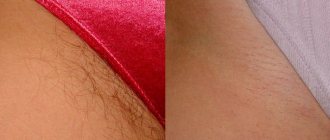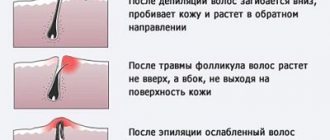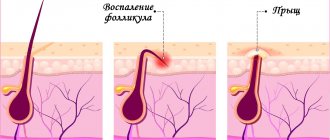What to do if your hair does not fall out?
Despite the fact that laser hair removal causes minimal possible harm to the body, any hair removal technique involves the provision of third-party effects on the skin. In addition, the effectiveness of the procedure directly depends on the time it is carried out. This is due to the fact that hair growth occurs through three stages:
- Anagen. During this period, the maximum rate of hair growth is observed.
- Catagen. The growth rate is slowing down. Hair follicles gradually die during this period due to lack of nutrition.
- Telogen. At this stage, hair stops growing.
The second nuance that determines the frequency of laser hair removal is that hair grows unevenly. Therefore, it is necessary to maintain an interval of 4-6 weeks between procedures.
The timing of laser hair removal is determined based on the individual characteristics of the person. In particular, if the procedure is prescribed to women whose skin is highly sensitive, then such an effect is not used a few days before the onset of menstruation. You should also not resort to laser hair removal during periods of hormonal imbalance. The latter reduce the effectiveness of the procedure.
Until the redness disappears, it is not recommended to treat the skin with alcohol solutions and cosmetics. During the first 24 hours, contact with water and (if possible) items of clothing should be avoided. After ablution, for the next two days you need to blot your skin with a towel rather than dry it. The latter will cause intense irritation.
For three days, it is prohibited to massage in the area that has undergone laser treatment. For similar reasons, you should not shave or pluck your hair after laser hair removal. This will also negatively affect the condition of the skin and can cause quite serious complications.
If hair has been removed from the face, it is recommended to immediately check with a cosmetologist about how long you should not sunbathe after laser hair removal. On average, this ban lasts for two weeks. This limitation is explained by the fact that after the procedure the sensitivity of the skin increases. And after the formation of a new tan, visiting a solarium, many complications arise in the form of burns, redness, and age spots. In some cases, chronic dermatoses worsen.
To avoid inflammation of the skin tissue, it is necessary to refrain from visiting baths, saunas, and swimming pools for two weeks. During this period, the use of antibacterial and hormonal drugs, antipsychotics and some other drugs is prohibited.
Why doesn't my hair fall out after laser hair removal? This outcome is possible when:
- The master conducted the session incorrectly. All parameters must be set correctly so that the laser beam can reach the hair follicle and act on it. If this does not happen, then there will be no result. Everything will remain in its place. To prevent this from happening, sign up for the procedure with an experienced specialist who has special training, knowledge and skills.
- The wrong type of laser has been selected. First, the specialist needs to look at what kind of vegetation the client has. If it is light or gray, then the alexandrite laser will not work on it. Here you will have to look for a diode. He can handle any structure and color.
- The hairline was in dormant mode. After two weeks, the hair that had fallen asleep comes out. Only those affected by the light pulse fall out.
- The client himself was incorrectly prepared for the manipulation. Do not pluck vegetation or remove it by the roots (use sugar or wax hair removal). The area that will be treated with laser should be shaved. Do not leave very long rods. Then the energy will go to the hair that is outside, and not to the root. This can also cause epilation to be ineffective, and therefore the hair will not fall out, but will remain in the same place. Before the session, you need to shave everything off 24-48 hours before the session.
To get rid of all vegetation you need to attend at least 4 sessions. It all depends on the zone and the individual characteristics of the person. For those who have little hair, 4-5 procedures are enough. Persons with increased hair growth need 10 or more procedures. There is a break of 1-2 months between sessions. During this period, something appears again, dormant follicles wake up, and there is something to work on again. The entire course can last from six months to a year.
If after two weeks you see that the vegetation remains where it was before and is firmly in place, you should think about changing the technician. You should first consult with a cosmetologist. Make sure it's not other hair.
What you need to know about the laser method
Among those who use this method of removing unnecessary vegetation, there are both supporters and opponents. In order to adequately assess all the disadvantages and advantages of the method, it is necessary to listen, first of all, to reliable information:
- any number of courses of such a procedure does not guarantee the complete destruction of vegetation, but only its significant reduction. New hairs still grow after the sessions, but they become thinner and lighter, resembling fluff. Therefore, they are simply not visible;
Remove hair forever: laser hair removal for smooth skin - the opinion that the bulk of vegetation falls out immediately after its treatment with rays does not correspond to reality. It begins to occur only after a week, and how long this process will last depends on the characteristics of the body;
- Painful sensations after a session sometimes last for several days, and not hours, as they say in the salon. How long this will take again depends on the body.
The fact that laser hair removal is painless cannot be said with complete confidence. Each person has their own sensation of pain. In addition, much depends on the structure and color of the vegetation, the area in which the removal is carried out and many other factors. It will be better if you tune in to unpleasant sensations before the session than to be completely unaware.
So how long after the procedure will excess hair not bother you?
Laser hair removal is one of the most effective, fastest and painless ways to remove unwanted hair.
What was on the surface, as well as the roots treated with the beam, fall out and do not grow for several years. But dormant bulbs can become active and appear on the skin for at least another six months. This is why it is necessary to carry out several sessions of removing vegetation.
So, having familiarized yourself with all the recommendations and having an idea of both the process itself and all the sensations accompanying it, you can, as they say, with open eyes, make a decision about the advisability of this event.
[Total: 2 Average: 3.5/5]
Rina Klim
Education
University: Kiev National University of Trade and Economics. Year of release: 2020.
How long does it take for hair to fall out after laser hair removal?
You shouldn't wait for immediate results. During the procedure, the bulbs only die. Hair falls out quickly after laser hair removal - within 1-3 days, but you most likely will not see it happening. After all, this process is not instantaneous, but gradual. That is, you will lose hair follicles during sleep, exercise, etc.
After laser hair removal, no more than 25% of the hair in the treated area falls out. This is explained by the fact that only those in the growth stage “respond” to the influence of the beam. And this is only ¼ of the hairline.
It is impossible to answer this question accurately. The procedure will be most effective if it is carried out during active hair growth. During this period, necrosis of the follicle almost always causes rejection of vegetation, which increases the chances of removal the first time. Therefore, it is recommended to perform laser hair removal every:
- 4-8 weeks (if eyebrows are processed);
- 4 months (bikini area and under the upper lip, lower limbs);
- 8 years (scalp).
We suggest you read: Peeling the scalp at home
If the procedure is carried out due to hormonal imbalance, more sessions will be required to achieve the desired result.
Operating principle
So, how long does it take for hair to fall out after laser hair removal? To understand this issue, you need to understand a little about the mechanics of this process.
The laser beam, penetrating through light skin, affects pigmented areas - in this case, hair follicles, and destroys the dark pigment in them. You may notice hair loss within a few days: due to the destruction of the hair follicles, those hairs that were in the active growth stage at the time of the procedure begin to fall out - that is, they were slightly visible through the skin. But you can read here how sugar hair removal is done at home in the bikini area and how painless such a procedure is.
After the first procedure, noticeable hair loss will begin after 7-10 days. This is the time during which the hairs from the destroyed follicles are rejected by the skin and come out. In their place, new ones may begin to grow, but softer and lighter. Subsequent procedures will relieve you of them too.
It will also be useful for you to learn more about which numbing cream to use for a bikini.
History of the discovery of the method
Hair lasers were first used in the 1990s. However, this method of hair removal became known about 20 years earlier. In the 1970s, scientists accidentally discovered that hair disappears when exposed to lasers.
Initially, the researchers did not pay attention to this phenomenon, since no visible damage remained on the skin after contact with the beam. But over time, scientists noticed that the treated area of the body was not covered with vegetation. After this, the time came for neodymium lasers in cosmetology.
Does hair grow after laser hair removal?
Destroyed follicles are not restored. That is, they will no longer make themselves known. After laser hair removal, only hair that was at rest and sleep grows. That is, having gone through the life cycle, they begin it again. And it is at this moment that the procedure should be repeated.
How long does hair not grow after laser hair removal?
As a rule, the interval between sessions is 14-20 days with subsequent increase, since each time after the procedure the life cycle of the remaining follicles slows down.
How to help hair loss after laser hair removal?
Laser hair removal is a procedure in which a laser beam acts on the hair follicle and burns it out. Over time, the vegetation disappears.
How long does hair fall out after laser hair removal? They fall out at different intervals. Rejection can occur in three days or 10. Most often this is a week or two. If the follicle is located shallowly, then it will not take much time. For deep-set ones, it takes time for them to be rejected.
It may also depend on:
- epilated area;
- the laser that was used;
- number of sessions performed;
- structures.
If the manipulation is carried out correctly, then all the vegetation that was in the growth phase - in the anagen stage - should fall out. The one that is in “sleep mode” will grow back. The impact on it will occur the next time the rod appears outside.
More vegetation is removed in areas such as:
- intimate areas;
- armpits;
- face.
These are hormone-dependent zones where vegetation grows wild. Here you can remove up to 80% in the first session. The bulk will fall out, taking into account that the session was carried out correctly.
It is not recommended to pluck hair either before or after hair removal. If you do this before the manipulation, the laser beam will not be able to recognize where the hair follicle is, since there will be nothing there. You cannot pull out the rod afterwards, as this can disrupt the entire process. Everything happens by itself. After 6-12 days the skin will be smooth and everything will fall out on its own.
Between procedures, it is also not recommended to remove hair from the roots. Waxing, sugaring, and depilatory hair removal are prohibited. Only shaving or depilatory cream is allowed. You should not bleach your hair. After this, they will not contain melanin, which means the laser beam will not “see” them.
Let's discuss shaving various parts of the body after laser hair removal. Since there are many different myths on this topic, let’s look at specific hair removal options.
Razor
Let's start with whether it is possible to shave your hair with a razor in the intervals between laser hair removal courses. Since the machine only removes hair without affecting the skin and hair follicle, it can be used. You can use absolutely any razor to remove emerging vegetation.
There is an assumption that after shaving with a machine, the hair will begin to grow stronger and become thicker. It is worth understanding that even if they begin to grow faster and become stiffer, the number of living hair follicles will not increase from such a procedure.
Important! The machine can be used to remove vegetation only after the skin has been completely restored.
That is, if you have, for example, 20 hairs and follicles left, then whether you shave them or not, the same number will remain. The point is different: over time, other bulbs will begin to “wake up”, from which hair will also begin to grow. But shaving does not affect this process in any way.
Epilator
Another pressing question: why you can’t pluck your hair after laser hair removal.
An epilator, unlike a razor, affects the integrity of the skin. You don’t just cut the hair, but pull it out “by the roots.” You damage the hair follicle, which is located in the skin. Such actions not only do not produce results, but also negate the work of the specialist who did your laser hair removal.
After your laser session, you should be given instructions on how to properly care for your skin after the procedure. These instructions will state that using any hair removal method that pulls out or damages the hair follicle is prohibited.
Wax
After laser hair removal, remaining hairs cannot be removed with wax. The point is not so much that you will waste money, but that your skin will receive secondary damage.
During the procedure, even when using the most advanced and weak lasers, the skin heats up and receives minor burns. And if after a certain time after this you apply hot wax and remove excess hair, then your skin, which has not fully recovered from the previous hair removal, will be damaged again.
Also,
. However, the hair does not always come out along with the hair follicles; often they remain in the skin, and unwanted hair begins to appear from them again. Thus, by the next hair removal you will have damaged skin and bulbs that will be impossible to remove with a laser.
We invite you to read: Ash hair color: all shades and paint review
The essence of laser hair removal comes down to the following: using a special tool, a high-intensity beam is applied to the hair follicle. With this effect, individual areas of the skin are heated due to the absorption of light by melanin (a special pigment that gives the dermis and hair a dark tint). As a result, destructive processes are launched, leading to the destruction of the follicle and nearby capillaries.
Due to the nature of the procedure and the high cost of equipment, laser hair removal at home is not recommended. For these purposes, you should contact a cosmetology office.
There are several laser hair removal techniques, differing in the type of installation, which are used to remove vegetation:
- Ruby laser. Emits shortwave radiation. This type of installation is used to remove dark hair, as well as age spots and tattoos on various parts of the body.
- Alexandrite laser. This type of installation is used in the fight against red and light-colored vegetation. You can perform hair removal with an alexandrite laser in areas with highly sensitive skin. The procedure is relatively quick.
- Diode laser. Suitable for all skin types. Diode hair removal is recommended for people with coarse and actively growing hair. This laser penetrates into the deep layers of the dermis, but the procedure takes quite a long time.
- Neodymium laser. Most effective in combating dark hair on dark skin. Laser hair removal with a neodymium laser also takes a lot of time.
The effectiveness of laser hair removal for blonde hair is extremely low. Other procedures are recommended to remove this type of vegetation. People with dark skin should not often use this method of hair removal, since due to the high melanin content, the radiation will be scattered in the layers of the skin without reaching the desired area.
The effectiveness of the procedure directly depends on compliance with the conditions of preparation for laser hair removal. Before the first session, you must stop plucking your hair for 2-4 months. During this period, it is recommended to avoid exposure to factors that injure the follicles.
For 2-4 weeks before laser hair removal, you should regularly treat exposed skin with sunscreen. Tanning contributes to the scattering of radiation in the layers of the dermis, as a result of which the effectiveness of the procedure decreases. This approach is also used to prevent the formation of age spots.
Most methods for removing vegetation have certain requirements for the latter. Therefore, before the first session, most people have a question about whether they need to shave before laser hair removal. The answer to this depends on the individual characteristics of the organism. It is optimal for laser hair removal if the hair length is 1-2 mm. Otherwise, such exposure may cause skin burns.
As part of the preparatory stage, the following conditions must be met:
- during the week before the procedure, do not treat the body with alcohol lotions and other solutions;
- on the day on which the procedure is scheduled, do not apply cosmetics to the skin;
- It is recommended to epilate hair with a laser 7 days before or a week after menstruation (skin sensitivity increases during this period)
A few days before the procedure, the patient is examined to determine skin color and identify contraindications to laser hair removal. At the same time, the nature of the body’s reaction to exposure to ultraviolet radiation is assessed. This approach allows you to select the most optimal technique for removing vegetation and reduce the likelihood of complications.
Laser hair removal gives the best results for people who have dark hair and fair skin. However, with proper preparation, the method allows you to get rid of body hair in most women.
Directly on the day of the procedure, the need for anesthesia is decided. To reduce the intensity of pain (the issue is especially important in cases where the intimate areas and axillary area are treated), special creams are applied to the body an hour before the session.
Before the procedure, the skin is cleansed of impurities and dried. After completing the preparatory stage, the cosmetologist begins to treat the skin. To do this, the specialist points the emitter at the problem area, holds it for a few seconds and moves it to a new area. This device generates laser pulses while simultaneously cooling the skin. This device anesthetizes the treated areas and prevents the development of the inflammatory process.
In most cases, people experience discomfort during the session. Sometimes there are tingling and pain sensations.
On the first day after laser hair removal, redness persists in the treatment area. During this period, skin sensitivity increases. Therefore, after the procedure, it is necessary to follow a number of recommendations with which you can avoid the development of complications.
If abnormal reactions occur at the end of the session (skin rashes, intense pain, etc.), you should seek medical help. Any non-standard manifestations may indicate the addition of bacterial microflora or the development of other dangerous complications.
In the first few days, it is recommended to apply anti-inflammatory creams and ointments to the skin. The choice should be made in favor of products that not only prevent complications, but also soften the skin. It is also necessary to apply medications to the body (Bepanten, Panthenol) that promote the regeneration of damaged tissues.
It is not uncommon to experience rapid hair growth in the first few days. This process should not be a cause for concern. This phenomenon indicates that the follicles are pushing out the remains of vegetation. Over time, the effect will disappear.
Conditions for the success of the procedure
The main condition on which the principle of this method is based is the contrast of skin and hair color. The better pigmented the hair and the lighter the skin, the better the effect. To successfully destroy a follicle, the laser needs to act only on it, and not on the skin and surrounding tissues. That is, if you have very light hair, the effect may differ from what you expected. If you have dark or heavily tanned skin, attempting to remove hair with a laser can result in burns or the appearance of age spots. The greater the contrast between hair and skin color, the higher the chances of success. But what is better, sugar or wax, and what you should pay attention to when carrying out the procedure, is indicated here.
Pregnant women and people with diabetes should not consider this procedure. There is no exact information about how dangerous it is for them and what the effect might be, but it’s not worth the risk. The same applies to the acute phase of any disease, especially infectious ones.
You can read here why irritation appears in the intimate area after the procedure and how to avoid such a problem.
For the first few days after the procedure, you will have to limit yourself to visiting the bathhouse, swimming pool, gym and other activities associated with increased sweating. Activation of the sweat glands will lead to folliculitis - inflammation of the hair follicles in the area of the skin where hair removal was performed.
The video shows the positive effects of laser hair removal:
Also, after the procedure and in between, you should not sunbathe or visit a solarium. This increases skin pigmentation and, as a result, may reduce the effectiveness of subsequent sessions. But how many procedures are needed and how each one is carried out is indicated here.
Pros and cons of this method
Does it cause harm? Among the disadvantages, the relatively high cost of the procedure is noted. Waxing and sugaring are several times cheaper, not to mention shaving. Here you only have to choose between cost and result.
As for pain, everything is individual. It is believed that laser hair removal causes only a slight tingling sensation, but often women report a fairly strong burning sensation during the procedure. This may depend both on your personal pain threshold and on the settings of the device itself. The cosmetologist performing the operation is responsible for the second factor, and the first can be adjusted using preliminary anesthesia. Typically, an anesthetic gel is used to reduce pain, which is applied some time before the session.
But you can read here how deep bikini photoepilation occurs and whether such a procedure can be carried out at home.
The video shows the positive features of the procedure:
Women who previously practiced hair removal using wax or sugar paste tolerate laser hair removal much more easily than those who previously only used a razor.
The advantages definitely include efficiency and quick results compared to other methods. More than half of the hair will be gone after the first procedure, and even if you decide not to continue, the result will still remain.
This procedure is also carried out with sugar, but you can see how it is done in this video.
If you complete the entire course to the end, a long-lasting effect is guaranteed: you will be able to forget about excess hair for 6-8 years. After this period, “dormant” follicles may become active, and you may notice some new hairs.
10 days ago I had laser hair removal for the first time. Now, something was supposed to happen to this hair? I understand that a small part was burned during the procedure. Then the entire surface was shaved smooth.
But now, what’s left has grown 3 mm and is falling out. I’ll run my fingernail there, and under the nail each time there will be 5-7 hairs. And I don’t understand, if the bulb were destroyed, how would it grow back? And if the onion remains, then why should he, especially after 10 days. fall out?
And I was told to use only a razor between sessions, and never wax, and the fact that the hairs are now falling out on their own is almost like wax.
How long does hair fall out after laser hair removal? They fall out after different amounts of time. It depends on various factors and individual characteristics of a person. Those who were in the sleep phase cannot leave.
Is it possible to shave hair after laser hair removal?
This way you get rid of the onion. True, not forever, but for a while. As a result, the hair life cycle will be disrupted and the session will have to be postponed to a later date. This, in turn, will lead to an increase in the number of procedures and, accordingly, to greater material costs.
Many girls do not know that before undergoing a laser hair removal session they need to shave their hair. Vegetation in the intimate area and armpits must be removed 1 day before the procedure, on other parts of the body - 3 days.
We invite you to read: Biotin for hair: uses, benefits and side effects
Advice! Before an hair removal session, you need to not only shave your legs, but also remove all makeup from the area where the operation is performed.
Why is this being done? Because
The procedure will take either 2-3 times longer, or its effectiveness will be extremely low. That is, the required amount of light and heat will not reach the hair follicle, which means that only a small part of the hair will fall out.
Another reason is burns. Many specialists, seeing “thickets” in front of them, simply set the beam power to maximum. This will not only increase pain, but can also cause burns or even scarring.
Reference! Holograms are created using lasers.
Many people are interested in the question of whether it is possible to remove hair after laser hair removal.
Results after a course of procedures
Due to the fact that hair grows unevenly, it will take several sessions to completely remove hair from certain areas. On average, this takes up to 3-8 procedures. The frequency of treatment is determined both by the individual characteristics of the human body and the area in which the vegetation is epilated. The duration of the session also depends on both indicators.
The results after laser hair removal become noticeable almost immediately. Hair begins to fall out at the moment the emitter sends light pulses. However, the maximum effect of the procedure is observed after several days.
Myth 4: After the procedure, scars will remain and hair will grow in
Sometimes, after two or three procedures, an increase in hair growth is actually observed; cosmetologists call this process “synchronization.” Oddly enough, this indicates the effectiveness of the procedure, being a kind of evidence that the technique “works”.
There is no reason to worry here. After the fourth procedure, the excess hair will go away, the hairs will become softer and sparser, and then completely disappear.
In fact, not a single cosmetologist can say with certainty how many procedures you personally will need for your hair to stop bothering you. The required number of beauty sessions is always individual, and depends on the area of the body that needs to be treated, the color and thickness of the hair.
In addition, unfortunately, in modern cosmetology there is no such procedure that eliminates it once and for all. You should know that laser hair removal is one of the best methods that removes hair for a long time, but it cannot give a lifetime guarantee.
Changes in hormonal levels, endocrine disorders, as well as other processes occurring in the body can contribute to the appearance of new hair. .
Contraindications and consequences
As with other hair removal procedures, laser hair removal has a relatively small list of contraindications and consequences. In particular, pregnant women are not recommended to use this technique. After conceiving a child, the sensitivity of a woman’s body increases, as a result of which pain may occur during the procedure.
There is a relatively small list of contraindications for laser hair removal. This hair removal technique is not recommended for persons under 18 years of age. This is explained by the fact that by this age the hormonal balance and, as a result, hair growth are normalized.
Also, you should not use a laser if the following circumstances are identified:
- increased skin sensitivity;
- the presence of wounds, scratches, moles, inflammation in the treatment area;
- exacerbation of an allergic reaction;
- recurrence of skin pathologies;
- course of diabetes mellitus;
- phlebeurysm;
- endocrine pathologies.
In addition, laser hair removal should not be performed when treating colds and viral diseases. Persons with very fair skin should consult a doctor before the first procedure.
Complications after laser hair removal occur for various reasons. One of the most common consequences after the procedure is considered to be an exacerbation of skin pathologies: herpes, psoriasis, various dermatoses. Recurrence of pathologies usually occurs in people with weakened immune systems.
The likelihood of burns from laser hair removal is determined by the competence of the cosmetologist. The latter must determine the skin type before the start of each session in order to select the radiation intensity.
Allergic reactions after the procedure occur mainly to anesthesia or cooling cream. In this case, itching, burning, and skin rashes appear in the treatment area.
Side effects of laser hair removal include the development of folliculitis. The disease is characterized by inflammation of the hair follicle. Folliculitis occurs in people suffering from active sweating. Also, the treated tissues become inflamed in cases where a person visited a sauna or bathhouse during the first two weeks after the procedure.
If after laser hair removal the body is exposed to intense ultraviolet radiation, then spots and black spots appear in problem areas. Hyperpigmentation of certain areas is possible in people with dark skin.
If, when treating the facial part of the head, the cosmetologist did not put protective glasses on the client, then in the event of contact of the laser beam with the eyes, conjunctivitis and photophobia develop. In such situations, partial or complete loss of vision cannot be ruled out.










